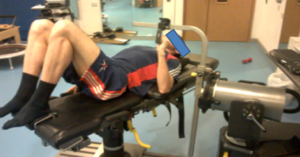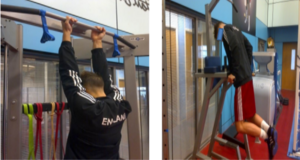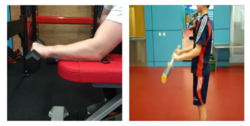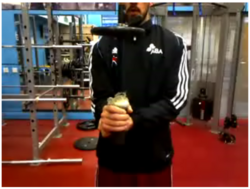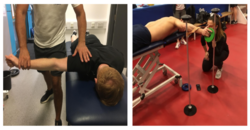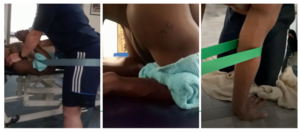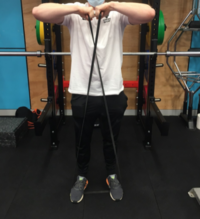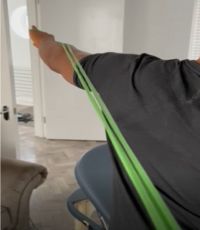Sporting Elbow - Management
Original Editor - Wanda van Niekerk based on the course by Ian Gatt
Top Contributors - Wanda van Niekerk, Kim Jackson, Robin Tacchetti and Jess Bell
Introduction[edit | edit source]
Elbow injuries in athletes occur in many sports and in athletes of all ages and levels. These injuries can have various causes such as acute trauma or overuse. Injuries can also range from catastrophic to minor. An effective elbow management treatment plan should include the identification of the causative factors of the injury to guide the design of the management plan. It will also steer the rehabilitation progression plan in a systematic way, so the athlete can return to their prior level of function in an efficient and safe manner.[1]
Read here for more information on: Sporting Elbow – Clinical Reasoning and Differential Diagnosis.
A multi-disciplinary team approach is a crucial part of the management of elbow injuries. For positive outcomes, a systematic and phased approach is necessary to progress exercises and stresses applied to the elbow. This will enable restoration of joint mobility, movement, motor control, strength and stability around the joint, as well as the whole kinetic chain.[1]
With the translation of clinical information obtained in the assessment of an elbow injury, it is wise to consider the following quote: “Not everything that matters can be measured… and not everything that can be measured matters.” [2]
Rehabilitation Objectives[edit | edit source]
- In the planning of a rehabilitation/management programme, it is necessary to consider both form and function and how these two go together in the management of an athlete with elbow pain.
- Consider and have a good understanding of the physiological knowledge of muscular strength vs muscular endurance and how / if this can influence the athlete's pain.
Exercise Prescription[edit | edit source]
Considerations with exercise prescription for the athlete with an elbow injury should include the following[2]:
- The purpose of the intended exercise
- Know what needs to be achieved – athlete expectations but also physiologically
- Is the exercise or rehabilitation engaging?
- It is important to keep the patient engaged and incorporate rehabilitation exercises into their already existing training programme where possible.
- Time - efficient
Exercise Therapy[edit | edit source]
Exercise therapy has been shown to be effective in the management of elbow pain, either as a stand-alone treatment, or as part of a multimodal treatment plan.[3] In the literature, there is no clear indication that a specific exercise regime or type of exercise is the best approach. There are studies (specifically on lateral elbow tendinopathy) that give preference to eccentric exercises over concentric exercise, while other studies show no differences between concentric or a combination of concentric and eccentric exercise programmes.[3] Types of exercise therapy in the management of the sporting elbow can include[2]:
- Isometric muscle contractions
- Occur when tension is developed in the muscle without movement, therefore the muscle origin and insertion does not move and there is no change in muscle length
- Isotonic muscle contractions
- Concentric muscle contractions: the muscle produces enough force to overcome the external resistance. The muscle shortens and there is movement at the joint.[4]
- Eccentric muscle contractions: the muscle lengthens while producing force. This happens because the external resistance moves in the direction opposite to the standard concentric (shortening) action.[4]
- Isokinetic muscle actions
- These muscle actions are characterised by constant velocity and can only be achieved in a laboratory or clinical setting. Specialised computerised equipment is necessary to maximise resistance at every angle of range of motion. Isokinetic contractions can be concentric or eccentric. These type of contractions and devices can help athletes perform exercises that simulate the actual speed and sport-specific activities.[4]
- Variation in the number of repetitions
- Variation in intensity levels
Another factor to consider is exercise-induced hypoalgesia (EID) when managing elbow pain.[5] This page provides valuable information on: Exercise and Activity in Pain Management.
Examples of Exercise Therapy[edit | edit source]
Isokinetic[edit | edit source]
Although this is mostly used for clinical testing, isokinetic exercise can be a useful management tool in elbow rehabilitation. The muscles around the elbow joint can be strengthened through the full range of motion. The use of this method needs to have merit and one should be sensible when deciding for which type of patient and condition this will be beneficial.[2]
Croisier et al.[6] reported that an isokinetic eccentric exercise programme was more effective than a non-strengthening exercise programme in patients with lateral epicondylalgia.
Isotonic[edit | edit source]
- Always consider the aim of the exercise
- Is the aim muscle strength, muscle endurance or pain relief?
- Methods that can be used[2]:
- Bodyweight
- Theraband
- Pulleys
- Weights
- Barbells
- Dumbbells
Anatomical Considerations in Elbow Exercise Therapy[edit | edit source]
Forearm Position[edit | edit source]
- Effect of forearm position on elbow flexors:
- Forearm pronation – brachialis stronger in this position with minor brachioradialis in play
- The position of the forearm neutral (thumb facing up) - brachioradialis is the main flexor of the elbow in this position
- Forearm supination - Biceps Brachii comes more into play and is also a supinator of the forearm
- Effect of forearm position on elbow extensors:
- Forearm in pronation or supination makes no difference on elbow extensors – there is no mechanical advantage as the triceps inserts onto the olecranon.
- However, the hand and wrist can play a role. In a supinated forearm position, there is not as much mechanical advantage for the hand and wrist as in a pronated position. Therefore, when performing elbow extension exercises to strengthen triceps, a way to isolate the triceps more is to perform the exercises with the forearm in supination. With the forearm in pronation, an elbow extension exercise may be easier, due to the mechanical advantage gained by the wrist flexors.[2]
Movement at Different Joints[edit | edit source]
- Wrist movement will influence the elbow and in conditions such as lateral and medial epicondylalgia
- Rehabilitation can be done with a fixed wrist with elbow movements or using wrist movements
- The type of sport and the type of action needed is important to consider with exercise therapy and when determining which joints need to move
- With forearm movements such as supination or pronation it is necessary to consider the importance of the proximal radioulnar joint in conjunction with the distal radioulnar joint in rehabilitation
- The addition of leverage to an exercise can influence the radiocarpal joint i.e. holding a tennis racquet or golf club. It can also influence mobility and stability around the area - think about the addition of extra weight and the influence it can have on eccentric control[2]
- Include the shoulder complex in the management plan:
- Overhead athletes often lose internal rotation and horizontal adduction range of motion. For these athletes, an 18° loss of internal rotation in the throwing shoulder can lead to elbow injuries.[1]
- A loss of external shoulder rotation range of motion may cause increased strain on the medial elbow during throwing.[1]
- Always consider the context and the available technology in a specific sport i.e. punch trackers in boxing[2]
Other Management Strategies[edit | edit source]
Joint Mobilisation[edit | edit source]
- Passive joint mobilisation
- Consider the use of mobilisation techniques in stiff elbows after surgery or traumatic injuries
- Read more about elbow mobilisation here: Elbow mobilisation
- Mulligan’s mobilisation with movement with the use of a belt is often used in the management of elbow injuries. However, in a recent systematic review on the effectiveness of Mulligan’s mobilisation with movement on peripheral joints, low-quality evidence was available for lateral epicondylalgia. Mobilisation with movement was reported to be superior to placebo and no-intervention control groups, but not superior to corticosteroids and other physiotherapy interventions.[7]
- Joint mobilisations directed at the elbow can improve pain and functional grip scores in individuals with lateral epicondylalgia, but higher-quality studies are needed.[8]
- In post-traumatic stiff elbows, there are anecdotal accounts that passive elbow mobilisations may lead to heterotopic ossification and a mechanical block to movement. Although studies have shown a relationship between forced movement and heterotopic ossification, it is important to note that these types of forceful manoeuvres “bear no resemblance to the passive mobilisations used by physiotherapists to address post-traumatic stiffness”.[9]
- Active mobilisations
- Using exercises is a good way to actively mobilise the elbow joint
- Find creative ways to gain range of motion for movements such as flexion and extension
- Consider the use of long and short levers in active mobilisation of the elbow joint:
- Especially in the early stages of rehabilitation of a condition where mobilisations are necessary, the patient can be given some autonomy in their rehabilitation with some easy exercises.
- Examples of using equipment to actively facilitate joint mobilisation
- To improve elbow flexion range of motion: instead of using a free weight and open-chain elbow flexion and extension exercise with a longer lever, consider using a light resistance band with elbows flexed and shoulders in 90 degrees abduction and pulling the band closer to the chin, thereby increasing flexion in the elbow.
- Another example is using a resistance band assisting with increasing flexion range of motion, here the band will pull the elbow into more flexion.
- As the patient progresses, the equipment can be changed to provide more resistance and make the exercise more difficult.
Pain Management, Stability and Proprioception[edit | edit source]
- End of range control
- Sometimes a patient with an elbow injury may be recovering well, but continues to have pain at the end of range of movements such as flexion and extension. Passive modalities such as taping can assist with pain management in these cases.[2]
- Using resistance bands to improve end of range control is also useful.
- Active forms of pain management can include:
- Other forms of passive pain management equipment/strategies include:
- Foam roller
- Peanuts
- Spiky balls[15]
- Other tools in your toolbox for pain management can include[16]:
- Soft tissue techniques
- Mobilisations
- Instrument assisted soft tissue techniques (IASTMs)
- Acupuncture
- Dry needling
- Shockwave therapy
Return to Play[edit | edit source]
Different factors to consider with the return to play decision making include[17]:
- Medical factors
- Patient demographics
- Symptoms
- Personal medical history
- Physical examination
- Lab tests and/or imaging
- Functional tests
- Athlete’s psychological state
- Potential seriousness of the condition
- Sport risk modifiers such as:
- Type of sport (collision sport vs non-contact sport)
- Player position
- Limb dominance
- Competitive level (recreational vs professional)
- Ability to protect the injured area (e.g. padding)
- Decision modifiers
- Timing and season
- Pressure from athlete (athlete’s desire to compete)
- External pressure (coach, parents)
- Masking the injury (effective analgesia)
- Conflict of interest (i.e. financial)
- Fear of litigation (e.g. if restricted or permitted)
Various factors can influence progression i.e. pain, physical characteristics and psychological factors.[2]
General Guidelines on the Management of the Sporting Elbow[edit | edit source]
Some key points to consider in the management of the sporting elbow include[2]:
- Consider physical qualities vs pain
- Consider objective and objectivity
- This will help to not prolong rehabilitation, but also identify the need for early or added intervention or referral to another member of the multidisciplinary (MDT) team
- Consider management of the complete kinetic chain vs local management
- Corticosteroid injections and/ or surgery (early vs late intervention)
- Short vs long term considerations
- Multidisciplinary team considerations – involvement and decision making that is in the best interest of the athlete
References[edit | edit source]
- ↑ 1.0 1.1 1.2 1.3 Wilk KE, Arrigo CA. Rehabilitation of Elbow Injuries: Nonoperative and Operative. Clinics in Sports Medicine. 2020 Jul 1;39(3):687-715.
- ↑ 2.00 2.01 2.02 2.03 2.04 2.05 2.06 2.07 2.08 2.09 2.10 2.11 Gatt, Ian. Sporting Elbow – Management Course. Plus. 2021
- ↑ 3.0 3.1 Coombes BK, Bisset L, Vicenzino B. Management of lateral elbow tendinopathy: one size does not fit all. journal of orthopaedic & sports physical therapy. 2015 Nov;45(11):938-49.
- ↑ 4.0 4.1 4.2 Rivera-Brown AM, Frontera MD. Principles of exercise physiology: Responses to acute exercise and long-term adaptations to training. PM&R. 2012; 4: 797-804.
- ↑ Vaegter HB, Jones MD. Exercise-induced hypoalgesia after acute and regular exercise: experimental and clinical manifestations and possible mechanisms in individuals with and without pain. Pain Reports. 2020 Sep;5(5).
- ↑ Croisier JL, Foidart-Dessalle M, Tinant F, Crielaard JM, Forthomme B. An isokinetic eccentric programme for the management of chronic lateral epicondylar tendinopathy. British journal of sports medicine. 2007 Apr 1;41(4):269-75.
- ↑ Westad K, Tjoestolvsen F, Hebron C. The effectiveness of Mulligan's mobilisation with movement (MWM) on peripheral joints in musculoskeletal (MSK) conditions: A systematic review. Musculoskeletal Science and Practice. 2019 Feb 1;39:157-63.
- ↑ Lucado AM, Dale RB, Vincent J, Day JM. Do joint mobilizations assist in the recovery of lateral elbow tendinopathy? A systematic review and meta-analysis. Journal of Hand Therapy. 2019 Apr 1;32(2):262-76.
- ↑ Jones V. Conservative management of the post-traumatic stiff elbow: a physiotherapist’s perspective. Shoulder & elbow. 2016 Apr;8(2):134-41.
- ↑ Alexis Booth. Towel Gapping Elbow Flexion - Self Mobilization. Available from:https://www.youtube.com/watch?v=tJjSnqhqkw8 [last accessed 19/01/2022]
- ↑ Kevin Campbell-Karn. Manual Therapy Passive Accessory Mobilisations for the elbow and forearm. Available from: https://www.youtube.com/watch?v=Aa23pcpjYYM&t=74s[last accessed 19/01/2022]
- ↑ Schiffke-Juhász B, Knobloch K, Vogt PM, Hoy L. Proprioceptive elbow training reduces pain and improves function in painful lateral epicondylitis—a prospective trial. Journal of Orthopaedic Surgery and Research. 2021 Dec;16(1):1-3.
- ↑ Tyler TF, Thomas GC, Nicholas SJ, McHugh MP. Addition of isolated wrist extensor eccentric exercise to standard treatment for chronic lateral epicondylosis: a prospective randomized trial. Journal of Shoulder and Elbow surgery. 2010 Sep 1;19(6):917-22.
- ↑ Tiwari M. Effectiveness of flex bar eccentric exercises versus progressive resistance exercises of wrist on pain, pain free grip strength and functional activities in sub acute tennis elbow. Indian J Physiother Occup Ther. 2018 Jul;12(3):28-32.
- ↑ Gatt I. Hand and wrist injuries: a focus on boxing. A Comprehensive Guide to Sports Physiology and Injury Management E-Book: an interdisciplinary approach. 2020 Nov 13:315.
- ↑ Bateman M, Saunders B, Littlewood C, Hill JC. Development of an optimised physiotherapist-led treatment protocol for lateral elbow tendinopathy: a consensus study using an online nominal group technique. BMJ open. 2021 Dec 1;11(12):e053841.
- ↑ Matheson GO, Shultz R, Bido J, Mitten MJ, Meeuwisse WH, Shrier I. Return-to-play decisions: are they the team physician's responsibility?. Clinical journal of sport medicine. 2011 Jan 1;21(1):25-30.
